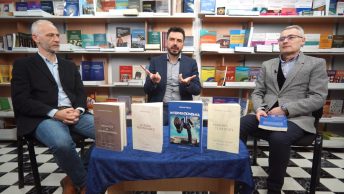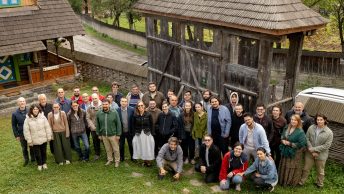Acestea sunt doar simptome ale maladiei contagioase de fond: nihilismul.
Din fisa de observatie & diagnosticul Dr. Kalomiros:
http://orthodoxyinfo.org/touchstone.pdf
«…Before the advent of our amazingly wondrous age, the Orthodox believed in Orthodoxy, the heretics in their heresy, the atheists in their atheism, and the one attempted to convince the other that he was in possession of the truth. People, that is, believed in truth and labored on its behalf, even those who were ignorant of the Truth. The terrible apostasy of our era is not due to the fact that the world is filled with heretics and atheists. All things being equal, they cannot but strengthen the faith of the pious, no matter how many they may be. Our contemporary apostasy is due to the fact that people today have ceased believing in the truth; they have ceased believing in the existence of truth and that it is worth struggling for. Heretics who believe in their heresy have become a rare species. Strange as it may seem, even the ideological atheists, who have some conviction in their type of atheism, are somewhat of a blessing in our era. People today have lost every conviction. All things to them are relative, doubtful, indefinite. Little exists for them that merits fighting for. Little appears worthy of their support except the pleasures of this fleeting life. In such a world, an atheist and a heretic of conviction are living islets in an ocean of death, because such conviction witnesses to a zeal for the truth, which, no matter how bereft of understanding, dark, or impassioned it may be, has not burned all the bridges connecting a soul with God, Who, even if they do not know and accept it, is Himself the Truth…
…
Ecumenism teaches that the truth is nowhere to be found. It is the assassination of the hope that has lived in the heart of man from time immemorial. It is the rejection of Truth and its supplantation with man-made truths. These man-made truths, of necessity, must make concessions, one to another, for the common good. Ecumenism is the last and most perfect trap that the devil has set for mankind and his most terrible, underhanded attack against the Church of Christ. It is that poison which paralyzes the soul and renders it incapable of believing, of seeing the light, incapable even of thirsting for the truth. It darkens the mind of the Orthodox Christian and affects him, so that instead of loving the sick and laboring to cure the illness, he ends up loving the very sickness; instead of loving the heretic, he ends up loving his heresy.
…
Constantinople opened the back door to Ecumenism in the year 1919. The Anglican or Episcopalian ‘Church,’ which had organized the ‘Ecumenical Movement,’ sent a deputation in that year to the Orthodox Churches, inviting them to send representatives to the ‘Faith and Order’ assembly of the Ecumenical Movement, which was to convene in Geneva in August of the following year. At that time, Dorotheus of Prusa was the
locum tenens of the Ecumenical Throne. At a meeting of the Patriarchal Synod on January 10, 1919, he stated, ‘I think it is more than time that the Orthodox Church also think seriously about the subject of the union of the individual Christian churches.’
The Synod was pleased to accept the suggestion of the locum tenens and proceeded to form committees, whose task it was to study the various ways this union might take place. In one year, by January, 1920, the historic Encyclical of the Ecumenical Patriarchate ‘To the Churches of Christ Wheresoever They Might Be’ was ready, and dispatched to all corners of the world. It elicited a universally enthusiastic response. Protestants of every denomination applauded the Ecumenical Patriarchate, and the Ecumenical Patriarchate has ever since preened itself for this encyclical which proves it to have been a pioneer in the Ecumenical Movement. According to this encyclical, the union of the churches would become a reality with the gradual erasure of differences between the ‘individual churches.’ As a first step, the encyclical suggested:
1. The adoption by all the Churches of one single calendar for the common celebration of the great Christian feasts (holy days),
2. The exchange of fraternal letters,
3. Fraternal contact between the representat ives of t h e Churches,
4. Establishment of relations among the divinity schools and exchange of documents and periodicals ‘of each church.’
5. Student exchange,
6. The convocation of pan-Christian assemblies,
7. An objective, historic examination of doctrinal differences,
8. Mutual respect of practices and customs of the various ‘churches.’
9. Mutual sharing of houses of prayer and cemeteries, for the burial ‘of adherents of other confessions.’
10. Implementation of common rules regarding mixed marriages, and
11. Mutual support in the realm of religious edification, philanthropy, etc.
A bishop who held the throne of Constantinople had not visited the West for centuries. The last to make such a visit was Patriarch Joseph who took part in the false Synod of Florence in 1439. (At that time only Saint Mark of Ephesus refused to sign the union of the Orthodox Catholic Churches with the Papacy.) That Patriarch had an inglorious end. Nonetheless, after so many centuries, it was he whom Dorotheus wished to emulate. Royalty, lords, and various officials received Dorotheus in England with great pomp. He was unable, however, to be present at the great ceremony prepared in his honor. He also died in the West far from his throne.
The conquest of Constantinople by Ecumenism, however, was a veritable fact. In a short time, the succeeding Patriarch of Constantinople, Meletius Metaxakis, recognized Anglican orders. A new wave of enthusiasm spread throughout the Protestant world. The English press reported, ‘The first step toward total outward union has been completed. The Orthodox will henceforth be able to receive the sacraments and other religious ministrations from the hands of the Anglican clergy.’ At the same time, common prayer with those in heresy commenced, and Anglicans began administering their sacraments to the Orthodox.
The Church of Greece was soon to join the Ecumenical Patriarchate in its Ecumenism. Chrysostom, the Archbishop of Athens, preached the ‘dialogue of love’ many years before Patriarch Athenagoras. This is what he said at his enthronement: ‘For the purpose of such cooperation and mutual help, doctrinal unity, unfortunately difficult to achieve, is not a necessary presupposition, since the bond of Christian love suffices, which, after all, can smooth the road toward union.’ The heresy of Ecumenism, therefore, in the form that it has taken today, did not appear with the advent of Athenagoras, as some would believe. It made its way into Orthodoxy during the time of Dorotheus, Meletius Metaxakis, and Chry s o s t o m Papadopoulos, when the Greek peoples were suffering martyrdoms at the hands of the Moslem Turks in Asia Minor.
The first official announcement of this heresy in Orthodox lands took place in 1920 with the Encyclical of the Ecumenical Patriarchate ‘To the Churches of Christ Wheresoever They Might Be.’ The first overt symptom of the illness, however, appeared in 1924. It was the application and implementation of the first suggestion of the 1920 Encyclical, that is, ‘the adoption by all the churches of one single calendar for the common celebration of the great Christian feasts,’ by which the liturgical or festal union of the ‘churches’ was accomplished.
…
Hence, we arrive at the strange ecclesiology of the new-calendarists, according to which it is not at all unnatural for a bishop who has revealed himself to be a devotee of extreme syncretism to demand that a monk, who belongs to his diocese but believes differently, be obliged to follow and commemorate him as his own bishop. Two different faiths, two different confessions, but one bishop. That which may be seen in the political life of the nation, where many different religions may exist but where there is but one national government, is now transposed to the spiritual level. Many religions, but only one authority. Can these people tell us how their ecclesiology differs from reprehensible syncretism?
…
They will tell you: ‘Of what concern is it to you if the Patriarch is a heretic, and if the Archbishops and Metropolitans commemorate him? The Patriarch is not our leader, but Christ. We know our hearts and our faith. We are Orthodox. Let the Patriarch declare whatever heresy he wishes. Let the Archbishops commemorate whom they will. They will have to answer for their souls and we for ours. Besides, we are sheep and it isn’t our place to speak out. This is the concern of the shepherds.’ Jesus, our Saviour, the Christ, has said that no one can come unto the Father except through the Son. Similarly, no one can approach the Son except through the Church. A Christian cannot exist as an individual, but only as a member of the Body of Christ, the Church. And the Church is there only where the Truth is confessed. Where Ecumenism that is, error is confessed, there is neither Church nor Christ. And do not think that this is the case only when Ecumenism is preached from the pulpit, though even this occurs frequently enough.
In the Church we confess our faith through the name of the bishop whom we commemorate. The Orthodox commemorate Orthodox bishops, Arians commemorate Arian bishops, Monophysites commemorate Monophysite bishops, Iconoclasts commemorate Iconoclast bishops, Uniates commemorate Uniate bishops, and Ecumenists commemorate Ecumenist bishops. It is possible for all things to appear Orthodox in the Church; however, the bishop who is commemorated by the priest will reveal to us where we truly are. In a Uniate church, all things appear to be Orthodox. Indeed, it is possible that the hair and beard of the priest there may be longer and fuller than those of the Orthodox. Also, the chant may be a great deal more liturgical and traditional, and the icons more austere than in some Orthodox Churches. The Creed itself in such a church may be recited without the Filioque insertion. But the priest there commemorates a Uniate bishop, who in turn commemorates the Pope of Rome. Thus all the appearances of Orthodoxy are for naught.
You may say that it matters little to you whom the priest commemorates since you believe in your heart that you are Orthodox. Would you, then, stay in a Uniate church to receive Holy Communion? But you do remain in a new-calendarist church. Everything there appears Orthodox. Your priest may even have long hair and a beard, and perhaps they have not yet sent you a ‘progressive’ preacher. But which bishop does that priest commemorate? And that bishop, which Patriarchs and Archbishops and Synods does he commemorate aloud or in the diptychs? Does he commemorate Demetrius, the Patriarch of Constantinople? And Demetrius whom does he have inscribed in the diptychs and whom does he commemorate at every Liturgy? Is it not his ‘elder brother,’ as he calls the Pope of Rome, Paul VI on every occasion? Why then flee from the Uniates, since either one way or the other you are commemorating the Pope?
The tragedy of our times is precisely that Orthodox Christians have been united to Rome without being aware that this has already taken place…»
(A. Kalomiros, The Touchstone, o bucata cunoscuta indeosebi pentru respingerea patristica si logica a detractorilor si falsificatorilor ordinii canonice a Bisericii.)
_________________________
A se vedea si Dostoievski, Demonii si alte scrieri; Cuv. Seraphim Rose, Nihilism; Cuv. Constantin Zaitsev, Dinaintea fetei lui Antihrist (in apendice la P. Serafim Rose/ Arhiep. Averchie Tausev, Apocalipsa în învățătura Sfinților Părinți, Ed. Icos, 2000.) Semnificatia textului Arhim. Constantin Zaitsev poate fi mai dificil de sesizat in absenta diagnosticului corect pus de Dr. Kalomiros mai sus, ceea ce explica, probabil, cvasi-absenta trimiterilor la el pe internet. El poate chiar suna destul de incomod la prima lectura, nu atat din din perspectiva cititorului ecumenist (al carui nihilism de fond il imunizeaza oricum la argumentatie), dar si din cea a anti-ecumenistului grabit. Un ecou notabil l-am gasit totusi aici http://www.filioque.com/farrell-continuum1.html, din pacate fara mentionarea completa sa sursei si cu unele concesii terminologice facute nefericitei ecleziologii augustiniene, insa altminteri patrunzator in sesizarea mesajului: conditia preliminara a oricarui dialog autentic inter-confesional si a posibilitatii ajungerii celor dornici la Adevar este lepadarea de ecumenism, sub toate formele sale!




